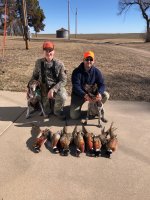I'm a first time poster and twenty year pheasant hunter in Kansas. I've noticed a lot of talk and some disagreement on the laws and public land debate on this forum. I don't know enough about those things to comment, but I do want to share my view on the actual hunting there.
I checked off a bucket list list item by going to South Dakota to hunt this year. It was a dream come true and I will treasure the memories for a lifetime. I killed 5 roosters and lost 2 more in 2 1/2 days. I hunt alone and without a dog. The number of birds I saw in wild flushes or heading back to cattail roosts at night was staggering.
One month later, I went on the first of my two trips to Kansas. I like to hunt late in the season when the corn is down and the birds have less places to hide. Ironically, I killed 5 roosters and lost two more in 2 1/2 days. Although the kill rate was the same as South Dakota, here's the difference. I could have presumably killed a few more, but once I killed a bird in a certain spot, I would stop hunting. I'm going on my last trip next week and I want to save some birds and not spook them for my son and grandson who will be joining me. As I'm sure many of you can relate, I find more joy in my loved ones getting into to birds than me killing a limit.
My point? Although South Dakota has a ton of birds, for guys like me who hunt alone or in small parties with no dog, Kansas is a better fit. There is less cover, but when you find good cover, it often holds birds. I have spent twenty years scouting to find a handful of spots that hold birds. Those spots often change year to year so it takes a few tanks of gas and wearing out some boot leather to find new places. But that is part of the lure for me. It's a challenge, a quest. For guys like me who love and need competition to keep life exciting, this is pure joy.
I checked off a bucket list list item by going to South Dakota to hunt this year. It was a dream come true and I will treasure the memories for a lifetime. I killed 5 roosters and lost 2 more in 2 1/2 days. I hunt alone and without a dog. The number of birds I saw in wild flushes or heading back to cattail roosts at night was staggering.
One month later, I went on the first of my two trips to Kansas. I like to hunt late in the season when the corn is down and the birds have less places to hide. Ironically, I killed 5 roosters and lost two more in 2 1/2 days. Although the kill rate was the same as South Dakota, here's the difference. I could have presumably killed a few more, but once I killed a bird in a certain spot, I would stop hunting. I'm going on my last trip next week and I want to save some birds and not spook them for my son and grandson who will be joining me. As I'm sure many of you can relate, I find more joy in my loved ones getting into to birds than me killing a limit.
My point? Although South Dakota has a ton of birds, for guys like me who hunt alone or in small parties with no dog, Kansas is a better fit. There is less cover, but when you find good cover, it often holds birds. I have spent twenty years scouting to find a handful of spots that hold birds. Those spots often change year to year so it takes a few tanks of gas and wearing out some boot leather to find new places. But that is part of the lure for me. It's a challenge, a quest. For guys like me who love and need competition to keep life exciting, this is pure joy.

